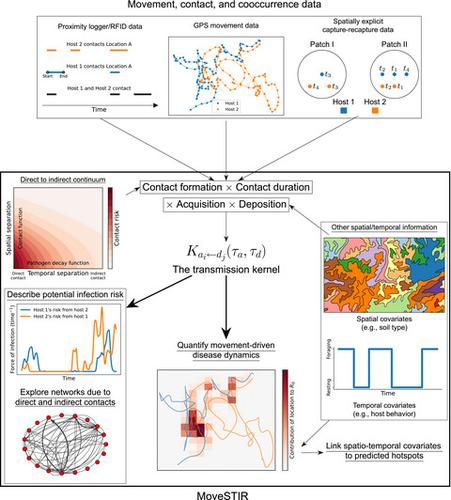当前位置:
X-MOL 学术
›
Ecol. Lett.
›
论文详情
Our official English website, www.x-mol.net, welcomes your
feedback! (Note: you will need to create a separate account there.)
A model for leveraging animal movement to understand spatio-temporal disease dynamics
Ecology Letters ( IF 7.6 ) Pub Date : 2022-03-08 , DOI: 10.1111/ele.13986 Mark Q Wilber 1 , Anni Yang 2, 3, 4 , Raoul Boughton 5 , Kezia R Manlove 6 , Ryan S Miller 7 , Kim M Pepin 2 , George Wittemyer 3
Ecology Letters ( IF 7.6 ) Pub Date : 2022-03-08 , DOI: 10.1111/ele.13986 Mark Q Wilber 1 , Anni Yang 2, 3, 4 , Raoul Boughton 5 , Kezia R Manlove 6 , Ryan S Miller 7 , Kim M Pepin 2 , George Wittemyer 3
Affiliation

|
The ongoing explosion of fine-resolution movement data in animal systems provides a unique opportunity to empirically quantify spatial, temporal and individual variation in transmission risk and improve our ability to forecast disease outbreaks. However, we lack a generalizable model that can leverage movement data to quantify transmission risk and how it affects pathogen invasion and persistence on heterogeneous landscapes. We developed a flexible model ‘Movement-driven modelling of spatio-temporal infection risk’ (MoveSTIR) that leverages diverse data on animal movement to derive metrics of direct and indirect contact by decomposing transmission into constituent processes of contact formation and duration and pathogen deposition and acquisition. We use MoveSTIR to demonstrate that ignoring fine-scale animal movements on actual landscapes can mis-characterize transmission risk and epidemiological dynamics. MoveSTIR unifies previous work on epidemiological contact networks and can address applied and theoretical questions at the nexus of movement and disease ecology.
中文翻译:

利用动物运动了解时空疾病动态的模型
动物系统中高分辨率运动数据的持续爆炸式增长提供了一个独特的机会,可以凭经验量化传播风险的空间、时间和个体差异,并提高我们预测疾病爆发的能力。然而,我们缺乏一个可推广的模型,该模型可以利用运动数据来量化传播风险以及它如何影响病原体入侵和异质景观的持久性。我们开发了一个灵活的模型“时空感染风险的运动驱动建模”(MoveSTIR),该模型利用动物运动的各种数据,通过将传播分解为接触形成和持续时间以及病原体沉积的组成过程来推导直接和间接接触的指标,以及获得。我们使用 MoveSTIR 来证明忽略实际景观上的精细动物运动可能会错误地描述传播风险和流行病学动态。MoveSTIR 统一了以前关于流行病学联系网络的工作,可以解决运动和疾病生态学关系中的应用和理论问题。
更新日期:2022-03-08
中文翻译:

利用动物运动了解时空疾病动态的模型
动物系统中高分辨率运动数据的持续爆炸式增长提供了一个独特的机会,可以凭经验量化传播风险的空间、时间和个体差异,并提高我们预测疾病爆发的能力。然而,我们缺乏一个可推广的模型,该模型可以利用运动数据来量化传播风险以及它如何影响病原体入侵和异质景观的持久性。我们开发了一个灵活的模型“时空感染风险的运动驱动建模”(MoveSTIR),该模型利用动物运动的各种数据,通过将传播分解为接触形成和持续时间以及病原体沉积的组成过程来推导直接和间接接触的指标,以及获得。我们使用 MoveSTIR 来证明忽略实际景观上的精细动物运动可能会错误地描述传播风险和流行病学动态。MoveSTIR 统一了以前关于流行病学联系网络的工作,可以解决运动和疾病生态学关系中的应用和理论问题。











































 京公网安备 11010802027423号
京公网安备 11010802027423号